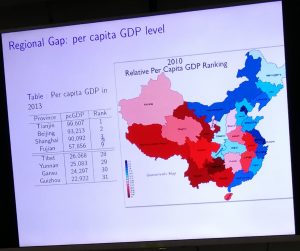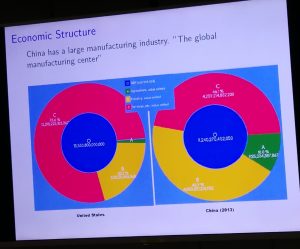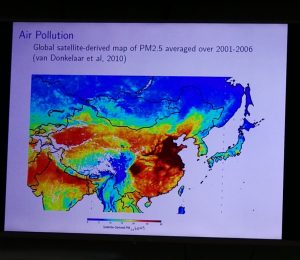Environment and Economic growth in China
Our first lecture in Xiamen University is Environment and Economic Growth in China, which was taught by professor Xiaojia Bao.
During this lecture, Professor Xiaojia Bao provided us with a lot comparisons between China and other countries in the world in many different aspects related to Environment and Economic Growth in China, such as GDP growth rate, rural-urban migration and so on. Apart from that, she also introduced some lines which divides China into two different parts according to special index such as heating, geography and demography and so on. Here are the main contents of this lecture:
1 . China GDP-Comparing with Japan and UK
According to the historical data, GDP of China surpasses that of Japan in 2010, and became the world second largest economy. However, in 2005, the GDP per capita in China is only $3500 while GDP per capita in UK is $4200. We can see that, five years ago, the Chinese GDP per capita is much more less than UK, but it really developed fast during these years.
However, the GDP in China is not average, and there exists different gaps between different cities in China, like the graph below shows. It is obvious to see from the graph above, the eastern part of China has higher GDP per capital than that of western area of China.

2 . The Reform and Opening-up policy.
The reason for China develops so fast during these 40 years is because:The Reform and Opening-up policy, was implemented in 1978.
The main content about Reform policy is to transform the national asset into private asset. And the main content about Opening-up policy is to trade with other countries. For example, Xiamen belongs to the earliest economic zone, it began to trade with Taiwan and western countries.
Because of The Reform and Opening-up policy,GDP of many coastal cities has grown faster than other cities in the inland China owing to benefits from the trade. As for some inland province relying mainly on resources, like Shanxi province, they really grow slowly.
3. Difference between Developing and Developed country
Difference between Developing and Developed country a personal way: the registration fee is different. For the developed country, the registration will be higher, as for developing countries, their registration fee will be lower.
4. Economic Structure between China and US
We can see from the picture below,compared with the US, China has a large manufacturing industry, which gives China a name called “The Global Manufacturing Centre”. As for the US, they have a large proportion of Service sector, which takes the account of about 78.6% of the whole production part.

5. Air pollution in China
In the lecture, professor Xiaojia Bao told us the difference between PM10 and PM2.5. PM10 is the particles with a diameter of 10 μm and PM2.5 is the particles with a diameter of 2.5 μm, which is much smaller than PM2.5. To some degree, PM2.5 is more difficult to prevent by individual, because it is too small to be blocked out of the facial mask.
In China, PM2.5 problem is a serious air pollution problem which is caused by emission of the traffic vehicles or factories, the lights in the evening (the light pollution)also brings bad effect to the environment. We can see the picture below. The places in the dark red are those seriously polluted by the PM2.5. And most of these places are coastal area and southeastern part of Chinese mainland. This is because many people gather here which make the city more prosperous and they will develop more in industry sectors and the traffic is also well developed.

Summary
The economy of a country has need to develop in the long term, but the development should not be carried based on the environment pollution or waste of resources. Although the pollution and nature destruction will happen during the economy development, the government and individuals should also pay more attention to how to develop in a green and environmental protection way. (sustainable development)
By Yiheng Chu
